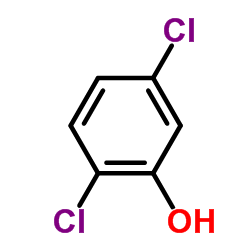2,5-Dichlorophenol

2,5-Dichlorophenol structure
|
Common Name | 2,5-Dichlorophenol | ||
|---|---|---|---|---|
| CAS Number | 583-78-8 | Molecular Weight | 163.001 | |
| Density | 1.5±0.1 g/cm3 | Boiling Point | 214.6±20.0 °C at 760 mmHg | |
| Molecular Formula | C6H4Cl2O | Melting Point | 54-57 °C(lit.) | |
| MSDS | Chinese USA | Flash Point | 100.0±15.8 °C | |
| Symbol |


GHS05, GHS07 |
Signal Word | Danger | |
|
The lin genes for γ-hexachlorocyclohexane degradation in Sphingomonas sp. MM-1 proved to be dispersed across multiple plasmids.
Biosci. Biotechnol. Biochem. 75(3) , 466-72, (2011) A γ-hexachlorocyclohexane (HCH)-degrading bacterium, Sphingomonas sp. MM-1, was isolated from soil contaminated with HCH isomers. Cultivation of MM-1 in the presence of γ-HCH led to the detection of five γ-HCH metabolites, γ-pentachlorocyclohexene, 2,5-dichlo... |
|
|
A fatal case of mothball intoxication presenting with refractory pruritus and ichthyosis.
Arch. Dermatol. 148(3) , 404-5, (2012)
|
|
|
Urinary concentrations of phthalates and phenols in a population of Spanish pregnant women and children
Environ. Int. 37(5) , 858-66, (2011) Background Phthalate and phenol exposure is prevalent among the general population and of potential concern for pregnant women and children because of their suspected susceptibility to endocrine effects. |
|
|
Levels of metals and organic substances in workers at a hazardous waste incinerator: a follow-up study.
Int. Arch. Occup. Environ. Health 82(4) , 519-28, (2009) To determine the blood and urine concentrations of a number of metals and organic substances in workers at a hazardous waste incinerator (HWI) in Catalonia, Spain, 8 years after regular operations in the facility. To compare these concentrations with the base... |
|
|
The kinetics of O-hexyl O-2,5-dichlorophenyl phosphoramidate hydrolysing activity in hen plasma.
Chem. Biol. Interact. 87(1-3) , 117-25, (1993) The organophosphorus (OP) compound O-hexyl-O-2,5-dichlorophenyl phosphoramidate (H-DCP) is hydrolysed in the plasma, liver and brain of hens and rats. We study in hen plasma the effect of tissue and substrate concentrations and of pH on the hydrolysing activi... |
|
|
Urinary 2,5-dichlorophenol as biological index for p-dichlorobenzene exposure in the general population.
Arch. Environ. Contam. Toxicol. 43(4) , 481-5, (2002) The relationship between exposure to p-dichlorobenzene (p-DCB) and urinary excretion of 2,5-dichlorophenol (2,5-DCP), the major metabolite of p-DCB, was examined to evaluate the usefulness of the metabolite as a biological index for low-level exposure of p-DC... |
|
|
Investigations on the mutagenicity of 1,4-dichlorobenzene and its main metabolite 2,5-dichlorophenol in vivo and in vitro.
Mutat. Res. 470(2) , 161-7, (2000) The genotoxic potential of 1,4-dichlorobenzene (1,4-DCB) has been extensively evaluated in vitro and in vivo. The majority of the studies demonstrated the absence of a genotoxic potential for 1, 4-DCB. At variance are a bone marrow micronucleus test (MNT) aft... |
|
|
Stability of the conjugated species of environmental phenols and parabens in human serum
Environ. Int. 35(8) , 1160-3, (2009) In humans, the metabolism of environmental phenols may include the formation of conjugated species (e.g., glucuronides and sulfates), but the free species—not the conjugated forms—are considered biologically active. Therefore, information on the concentration... |
|
|
The association between urinary concentrations of dichlorophenol pesticides and obesity in children.
Rev. Environ. Health 26(3) , 215-9, (2011) Increasing prevalence of childhood obesity has been seen in the United States and other parts of the world. Environmental chemical exposures might play a role in the worldwide obesity epidemic.This study was conducted to assess the association of exposure to ... |
|
|
Mothball withdrawal encephalopathy: case report and review of paradichlorobenzene neurotoxicity.
Subst. Abus. 27(4) , 63-7, (2006) Paradichlorobenzene (PDB) is a common household deodorant and pesticide found in room deodorizers, toilet bowl fresheners, and some mothballs. Although human exposure to the compound is generally limited and harmless, PDB in larger doses can produce neurotoxi... |